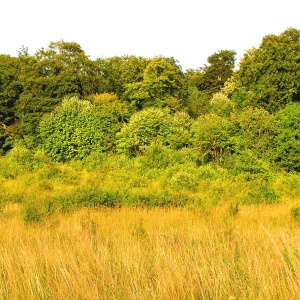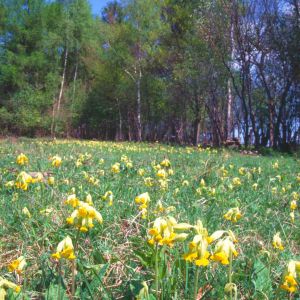
Bernwood Forest & Meadows Walks | Map | Calendar | Top of the page
The two sites straddle the county boundary, with the forest in Buckinghamshire and the meadows in Oxfordshire.
Also known as Shabbington Wood, the forest is part of the ancient royal hunting forest of Bernwood. Today it is managed by Forestry Enterprise and is a mixture of conifer, oak and birch woodland, with a network of wide sunny rides which create an ideal habitat for a wide variety of wildflowers, together with the insects that they attract. It has a reputation as one of the best butterfly sites in Britain: about forty species have been spotted over the years, including the rare black hairstreak. Huge wood ant nests are a conspicuous feature of some parts of the forest and on summer evenings glow-worms can be seen displaying along the rides. Nuthatches, green and great spotted woodpeckers are a common sight and with luck we might catch glimpses of buzzards or deer (muntjac, roe and fallow deer all live within the forest).
Bernwood meadows are traditional old 'ridge-and-furrow' fields which have escaped ploughing and pesticides. In spring and summer they form a spectacular display of grassland flowers, many of which have disappeared from the surrounding countryside. Green-winged orchid, ox-eye daisy, yellow rattle, knapweeds and lady's bedstraw all thrive here, along with a host of butterflies and the beautiful (but deadly) burnet moth. The meadows are managed by the Berkshire, Buckinghamshire & Oxfordshire Wildlife Trust (BBOWT). You can find out more about the reserve and the Trust on their website (www.bbowt.org.uk), or in their reserve handbook 'Where 2 go 4 Wildlife', available from BBOWT, The Lodge, 1 Armstrong Road, Littlemore, Oxford OX4 4XT.

Dancersend Walks | Map | Calendar | Top of the page
Hidden in a sheltered Chiltern valley, Dancersend is a patchwork of habitats, each supporting its own distinctive mix of plants, animals and fungi. There are areas of scrub and chalk downland, with carpets of wildflowers that include orchids, marjoram, St. John's-wort and Chiltern gentian (now the county flower of Buckinghamshire) and mixed woodland with primroses in the spring and a rich variety of fungi in the autumn and winter, including earth stars and the striking scarlet elf-cup. In all almost 300 plant species have been found at Dancersend, attracting butterflies such as meadow brown, gatekeeper, ringlet, marbled white and the rare Duke of Burgundy. Buzzards, sparrowhawks and red kites are regularly seen overhead and there are often glimpses of muntjac and roe deer in the woods. After dark there are badgers, foxes, glow-worms and edible dormice (the dormice were introduced a few miles away in Tring Park over a century ago and are now marching their way along the Chilterns).
Dancersend is managed by the Berkshire, Buckinghamshire & Oxfordshire Wildlife Trust (BBOWT). You can find out more about the reserve and the Trust on their website (www.bbowt.org.uk), or in their reserve handbook 'Where 2 go 4 Wildlife', available from BBOWT, The Lodge, 1 Armstrong Road, Littlemore, Oxford OX4 4XT.

Dry Sandford Pit Walks | Map | Calendar | Top of the page
Until the 1950s what is now the reserve was a sand and limestone quarry and ironically it was the quarrying that allowed the site to become such a rich habitat for wildlife. The walls of the quarry now provide a home for about a hundred species of burrowing bees and wasps. They are also packed with fossils dating back 160 million years, to a time when dinosaurs were young and Oxfordshire lay at the bottom of a warm shallow sea.
The floors of the old quarry create a sunny, sheltered habitat for a wide range of grassland wildflowers, including bird's-foot trefoil, salad burnet and knapweeds, dotted with taller plants such as guelder rose, spindle and wayfaring tree. The carpets of flowers in turn attract butterflies (such as marbled white, meadow brown, skippers and blues), bumblebees, grasshoppers, bush-crickets and many other insects.
The deepest parts of the quarry are now flooded, forming a series of shallow ponds fringed with marshland. These support their own distinctive wildlife, including dragonflies, damselflies, frogs, newts and even the occasional kingfisher, with a beautiful display of marsh helleborines in July.
Dry Sandford Pit Reserve is managed by the Berkshire, Buckinghamshire & Oxfordshire Wildlife Trust (BBOWT). You can find out more about the reserve and the Trust on their website (www.bbowt.org.uk), or in their reserve handbook 'Where 2 go 4 Wildlife', available from BBOWT, The Lodge, 1 Armstrong Road, Littlemore, Oxford OX4 4XT.

Grangelands Walks | Map | Calendar | Top of the page
This 63-acre reserve, managed by Buckinghamshire County Council forms part of a two-mile chain of wildlife sites stretching from Brush Hill at the south-west end to Ellesborough Warren at the north-east and all linked by the ancient Ridgeway path, which is believed to date back several thousand years and overlooked by the Iron Age hillfort of Pulpit Hill.
The lower slopes of Grangelands were ploughed during World War II, but have recovered remarkably well and now support a patchwork of chalk grassland and scrub, rich in plants such as common centaury, knapweeds, bellflowers, harebells, orchids and the strange adder's-tongue fern. They are also home to a large number of junipers (a species which has been declining for at least 50 years, though no-one knows why) and the introduced Roman snail, which roam the reserve in large numbers, particularly after rain. At the northern edge of the reserve is Happy Valley, containing Britain's largest stand of box woodland.

Park Wood Walks | Map | Calendar | Top of the page
Park Wood is almost a living textbook of the ways in which people have altered and managed the Chilterns and their wildlife since prehistoric times. As far back as the Bronze Age, four thousand years ago, it was part of one of the Chilterns' main farming areas and much of what is now Park Wood would have been open grassland and scrub.
By Tudor times part of the land had become a deer park (hence the name) and later still, in the 18th and 19th centuries, much of the wood was planted with beech to feed High Wycombe's furniture industry. Nowadays the thousand-acre Bradenham Estate, of which the wood is just one part, is managed by the National Trust. Each of these chapters of Park Wood's history has left its legacy of habitats and wildlife which can still be enjoyed today.
The woods are a mixture of beech, cherry, holly, whitebeam and yew, beneath which grow yellow archangel, woodruff and the delicate, white-flowered sanicle. In summer the grass banks are alive with butterflies feeding on the agrimony, scabious, marjoram, thyme, wild basil, restharrow and knapweed, and amongst the scrub there are primroses, dog rose, pyramidal and common spotted orchids and wayfaring tree.

Rushbeds Wood Walks | Map | Calendar | Top of the page
This is a surviving fragment of the old royal hunting forest of Bernwood. Though most of the trees were felled in the 1940s, new ones have taken their place and the wood has held on to many of the plants that grow only in ancient woodland, such as bluebells and the tiny moschatel (also known as town-hall-clock). The wide, sunny ride that runs through the centre of the wood is an excellent place to look for butterflies and other insects, while in the wood itself there are usually woodpeckers and warblers, with the possibility of seeing and hearing buzzards. Attached to the wood is a wonderful meadow, alive in summer with carpets of wildflowers and the sound of grasshoppers.
Rushbeds Wood is managed by the Berkshire, Buckinghamshire & Oxfordshire Wildlife Trust (BBOWT). You can find out more about the reserve and the Trust on their website (www.bbowt.org.uk), or in their reserve handbook 'Where 2 go 4 Wildlife', available from BBOWT, The Lodge, 1 Armstrong Road, Littlemore, Oxford OX4 4XT.

Warburg reserve Walks | Map | Calendar | Top of the page
Set in the secluded Bix valley just a few miles north-west of Henley, the Warburg reserve contains a mixture of all the habitats you might expect to find in the Chilterns, with beech and mixed woodland, chalk grassland, scrub and hazel coppice. More than 450 plant species have been found here, including 15 species of orchid, along with over 900 species of fungi.
The sunny but sheltered grassland rides are a perfect habitat for butterflies like the marbled white, skippers, blues and the ringlet, as well as slow-worms and the occasional glimpse of a grass snake disappearing into the undergrowth. In summer you are almost guaranteed views of red kites and buzzards soaring overhead.
The woods are the place to look for fungi, to hear tawny owls and to glimpse deer (both muntjac and fallow), In summer they are home to the tiny but beautiful fly orchid, which mimics a female wasp in order to fool males into pollinating it. The strange herb paris, its leaves and flower parts all arranged in clusters of four, can also be found in the woods, together with Solomon's seal.
The Warburg reserve is managed by the Berkshire, Buckinghamshire & Oxfordshire Wildlife Trust (BBOWT). You can find out more about the reserve and the Trust on their website (www.bbowt.org.uk), or in their reserve handbook 'Where 2 go 4 Wildlife', available from BBOWT, The Lodge, 1 Armstrong Road, Littlemore, Oxford OX4 4XT.